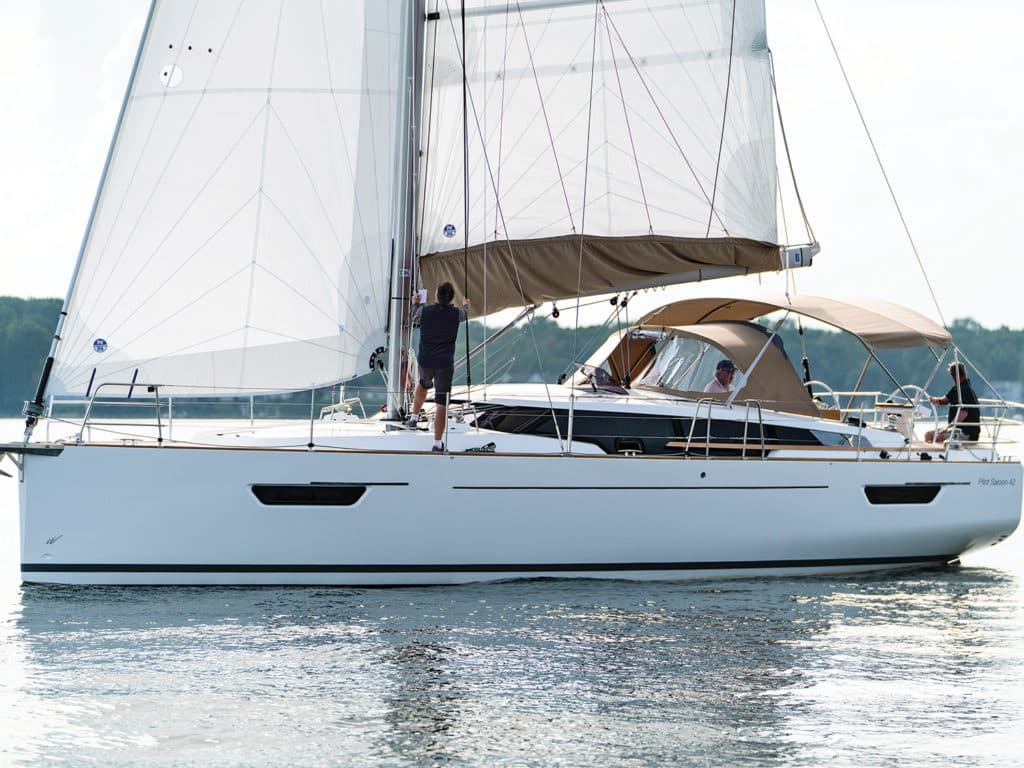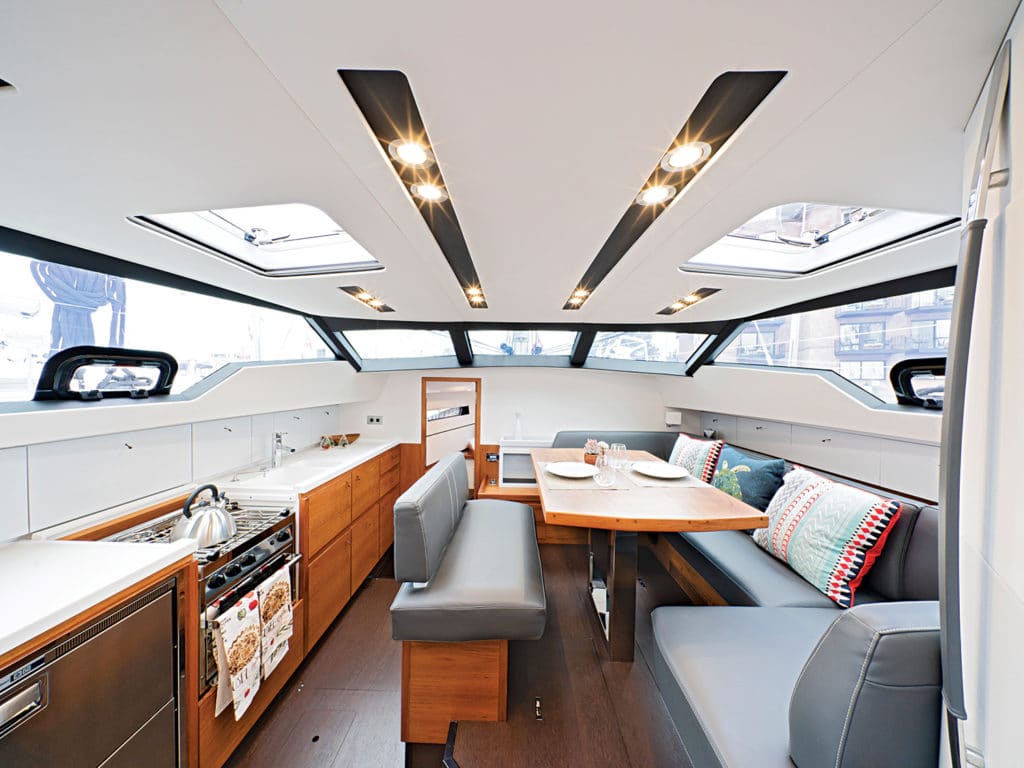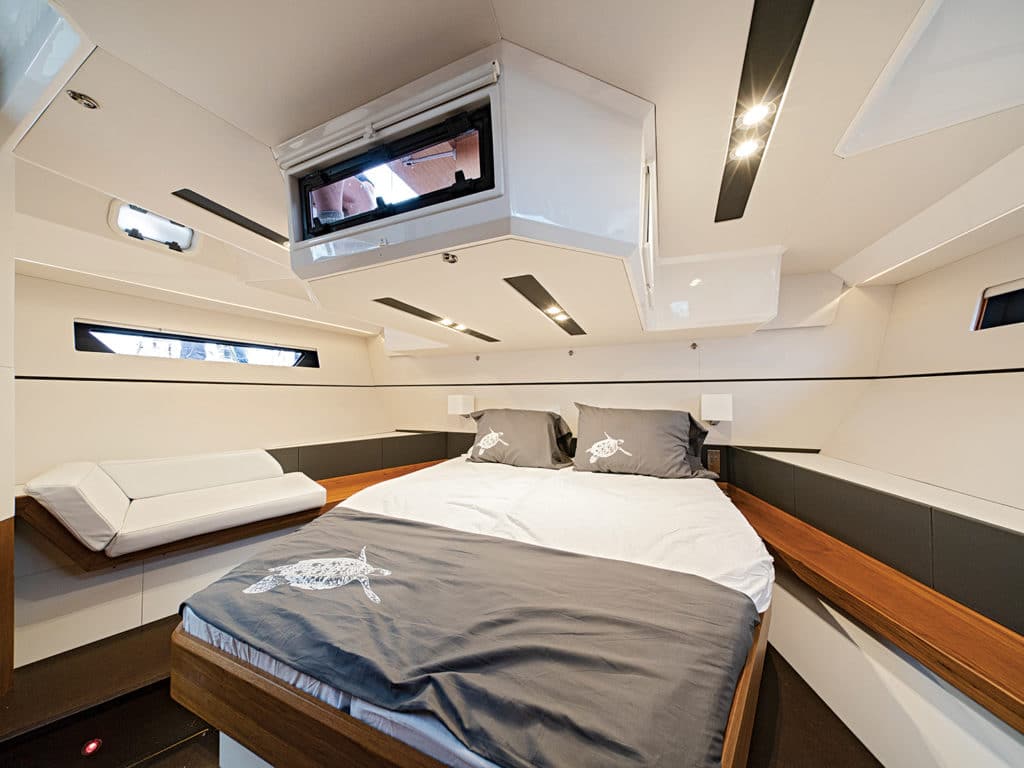
French boatbuilder Henri Wauquiez cut quite the dashing figure. As a pilot in the French army in the mid-1950s, he earned a medal of valor for his reconnaissance flights over the mountains of Algeria, a country then torn by conflict. After his service, he began his boatbuilding career a decade later with a 30-footer called the Elizabethan. But he became famous and successful for his Centurion, Gladiateur and Prétorian models, all names from one of his favorite works of literature, perhaps not coincidentally, Jean Lartéguy’s Guerre d’Algérie (The War of Algeria). For several decades, he was a fixture at boat shows around the planet, trim and handsome, looking every bit the French war hero. Seriously, he was right out of central casting.
Alas, Wauquiez is no longer with us, but his name and legacy continues at the Wauquiez Shipyard, primarily with a series of pilot-saloon yachts, including the latest, the Wauquiez Pilot Saloon 42. It’s designed by ubiquitous naval architecture firm Berret-Racoupeau, perhaps the most prolific sailboat designers of this period. (The boat is imported and sold in the United States by Dream Yacht Charters.)
It seems odd to call a pilot-saloon yacht a rather “traditional” configuration—it wasn’t long ago at all that Oyster and Moody, and many copycats, made the raised deck such a popular option—but in these current days of beamy, voluminous rocket ships, the notion is almost quaint. And don’t get me wrong—the 42 certainly has modern features: a nearly max waterline, twin wheels and rudders, a drop-down transom with swim/boarding deck, and a hull chine that opens up the interior and carries the beam well aft. But it’s also a bit of a throwback.
It certainly is a solidly built one. The composite construction is resin-infused with a balsa core that extends the length and breadth of the hull, from the toe rail to the keel, with an outer coat of vinylester to prevent water intrusion. The bulkheads are laminated marine plywood that are tabbed in to provide a secondary bond to the hull. The nicely finished interior furniture is teak. There is a substantial bulwark on deck capped with more teak.
Once you descend the six steps from the cockpit into the saloon (and the term “pilot saloon” is a bit of a misnomer; there are no steering controls to pilot the boat from down below), there is a whole lot going on. The most immediate and striking feature is the dimmable glass (and yes, that’s real glass), an unusual sight in a sailboat, facilitated by sensors embedded in the electrically charged wraparound window. With its blue tint, it certainly provides atmosphere. Like, very cool.

The layout of our test boat included the owner’s stateroom aft (alternatively, you could opt for a pair of double cabins). The berth is roomy and comfortable, with easy side entry, and there’s immediate access to a large head to starboard. The central saloon, also to starboard, indeed has great views of the surroundings, with a large, U-shaped leather settee surrounding a big dining table. Opposite, to port, is an efficient, straight-line galley adjacent to the navigation station. Just forward of that dining table is a hideaway compartment to stash a flat-screen television; interestingly, this feature isn’t specified for boats going into the European markets, the (rather hilarious) implication being that those folks have better things to do with their time than we easily bored Americans. A second double stateroom is situated in the bow, with its own en suite head.
Unfortunately, during our Boat of the Year sea trials on Chesapeake Bay this past fall, we were completely skunked for breeze the day of our scheduled sail test. But judge Alvah Simon was still impressed by much of what he inspected.
“It had nice scuppers, they thought about drainage in the boat, in the cockpit and everywhere,” he said. “I loved the pushpit and the pulpits; there were three railings on each, really stout ones. The cleats were great. The layout of the foredeck was just beautiful. The jacklines were the best in the entire fleet, I hadn’t seen any pad eyes and jackline setups that were as good as these. So, you start to get the feeling that whoever is setting all this up, they’ve been to sea and they know what works.”
For working sail, the 42 employs a traditional mainsail and a 100 percent, non-overlapping jib on a dedicated self-tacking track; there’s a fancy stainless-steel bow fitting with a sprit for tacking down a cruising kite or code-zero-type genoa. There’s no traveler; this is a cruising boat, friends.

Running rigging is led below deck, not to the coach roof, but rather to coamings port and starboard, where they’re handled by a set of Andersen winches. There are steering pods for each helm, with Raymarine chart plotters on each, and controls for the autopilot and bow thruster on the starboard pod (the engine controls are at the base of this steering station as well). There’s a gargantuan locker beneath the cockpit that is accessed through a hatch between the wheels. A good-size cockpit table has double leaves; the cockpit cushions and cushioned backrests are excellent. There’s a generous Bimini overhead, which provides plenty of shade but makes it a bit tricky getting in and out of the cockpit. The companionway hatch slides right into the deck, which is a pretty nifty arrangement.
Our test boat was bound for service on the Chesapeake and for southbound forays down the Intracoastal Waterway, and was thus equipped with the shallower of two keel options, as well as a slightly shorter rig than the standard one for bridge clearance. For the very same reasons, it was powered by the larger of two available engines: an 80 hp Yanmar diesel (as opposed to the regular 57 hp auxiliary).
For running the ICW, it sounds like the perfect setup. Henri Wauquiez, I think, would approve. Yes, the Carolinas are a far cry from the stark shores of Algeria. But once his wars were over, he spent the better part of his days crafting boats that can cruise far and wide, which is his true, lasting legacy. The Pilot Saloon 42 carries it on.
Wauquiez Pilot Saloon 42 Specifications
| LENGTH OVERALL | 42’6″ (12.99 m) |
| WATERLINE LENGTH | 38’6″ (11.79 m) |
| BEAM | 14’2″ (4.34 m) |
| DRAFT | 5’5″/7’1″ (1.7/2.2 m) |
| SAIL AREA (100%) | 973 sq. ft. (87 sq. m) |
| BALLAST | 9,259 lb. (4,199 kg) |
| DISPLACEMENT | 26,550 lb. (12,043 kg) |
| BALLAST/DISPLACEMENT | 0.34 |
| DISPLACEMENT/LENGTH | 197 |
| SAIL AREA/DISPLACEMENT | 17.9 |
| WATER | 162 gal. (613 L) |
| FUEL | 110 gal. (416 L) |
| HOLDING | 10 gal. (40 L) |
| MAST HEIGHT | 62’10” (19.17 m) |
| ENGINE SPECIFICATIONS | Yanmar 57 hp |
| DESIGNER | Berret-Racoupeau |
| PRICE | $630,000 |
Dream Yacht Sales
833-450-4211
dreamyachtsales.com
Sea Trial
WIND SPEED
Zero knots
SEA STATE
Flat
SAILING
Closehauled N/A
Reaching N/A
MOTORING
Cruise (2,400 rpm) 6.3 knots
Fast (2,700 rpm) 7.5 knots








